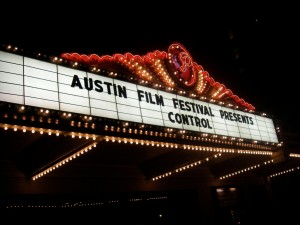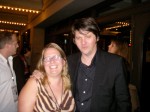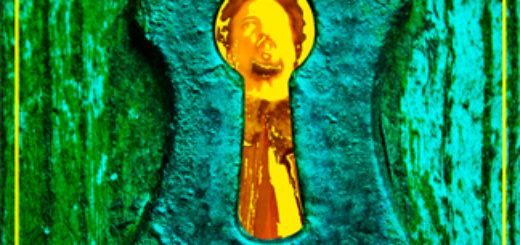Finding Joy in “Control” — The Biopic on Joy Division, a Post-Punk Band
Ever since high school I’ve been into the distinctively mopey music that emerged from economically depressed Manchester, England in the 1970s and ’80s. The Smiths and Joy Division are still two of my favorite bands, though I realize their stylishly despondent sound might not be for everyone.
That being the case, naturally the film I’ve most been looking forward to in this festival was the Saturday night showing of Control, by director Anton Corbijn. It’s a new black and white film about Ian Curtis, lead singer of post-punk band Joy Division. Their best known song: Love Will Tear Us Apart.
Immediately before this regional premiere of the film, producer Orian Williams stepped onto the Paramount Theater stage to reveal how and why he brought this film to life.
 It started a decade ago with Williams buying the book Touching From a Distance, written by Ian Curtis’ widow, Deborah. Williams thought the book would make a great movie, so he started trying to make that happen. It’s a good thing he did, because the film is just wonderful.
It started a decade ago with Williams buying the book Touching From a Distance, written by Ian Curtis’ widow, Deborah. Williams thought the book would make a great movie, so he started trying to make that happen. It’s a good thing he did, because the film is just wonderful.
Sitting near the front of the 1915 theater and staring at the Paramount’s ginormous silver screen was as close as I’ll ever get to seeing Joy Division play. Watching the film was transcendent. The actors actually rerecorded all of the music, though they are lip-synching to their very own takes. This makes the film feel really vibrant and alive, not just a story about a band that last performed nearly thirty years ago. Actor Sam Riley does a brilliant job of bringing Curtis to life on screen.
While Joy Division’s music might not be for everyone, the difficulties that Curtis struggled with in his personal life are something most of us can understand. Control is a love story of sorts, documenting the emotional triangle between Curtis, his wife, and his mistress.
When Curtis’ wife accuses him of being in love with another woman, his questioning response of, “Yeah, but what’s that got to do with us?” drew a wave of nervous laughter from the audience. The film also explored the problems that Curtis had with frequent epileptic seizures.
As for the film’s audience, I had expected more of Austin’s club kids to be at the screening. Yet, I didn’t see many from the black-clad, quasi-goth community. Is Joy Division just not cool anymore? At the screening, I did, however, run into my pal Barbara, whom I noticed because she was second in line for the screening. An Austin resident, she’d been home on her computer, and hadn’t planned on coming to any Saturday night films. Yet, when she heard a story on NPR about Control, she was compelled to come on down to see the screening.
 Not long after the film played, I snagged a picture with Williams. He’s dapperly dressed in dashing all-black, perfect for introducing his new film about Joy Division. In the photo, I’m clearly a little too tiger-striped for the evening. Unfortunately, I had abandoned my original plan to dress in all-black in homage to Curtis, when I realized my key all-black ensemble was in the laundry. C’est la vie.
Not long after the film played, I snagged a picture with Williams. He’s dapperly dressed in dashing all-black, perfect for introducing his new film about Joy Division. In the photo, I’m clearly a little too tiger-striped for the evening. Unfortunately, I had abandoned my original plan to dress in all-black in homage to Curtis, when I realized my key all-black ensemble was in the laundry. C’est la vie.
I finished up the evening strolling down scenic Congress Avenue, where the Paramount is located. Congress is a wide and graceful street, anchored at the north end by the meticulously restored 1888 Texas State Capitol, made of local pink granite.
It was only a short stroll south from the Paramount to the Conference Wrap Party at McCormick & Schmick’s. I mostly wanted to go because the restaurant is located inside Austin’s newest landmark building, the Frost Bank Tower. Though I’ve seen the bar from the outside countless times walking by, I’d never been inside.
Alas, the party was so overcrowded that I quickly fled the space in favor of spending more time out on the pleasant street. Looking back up Congress, I thought how lucky I am to live in such a pretty, pretty city. Not in the decaying industrial center of Manchester of the 1970s.






















